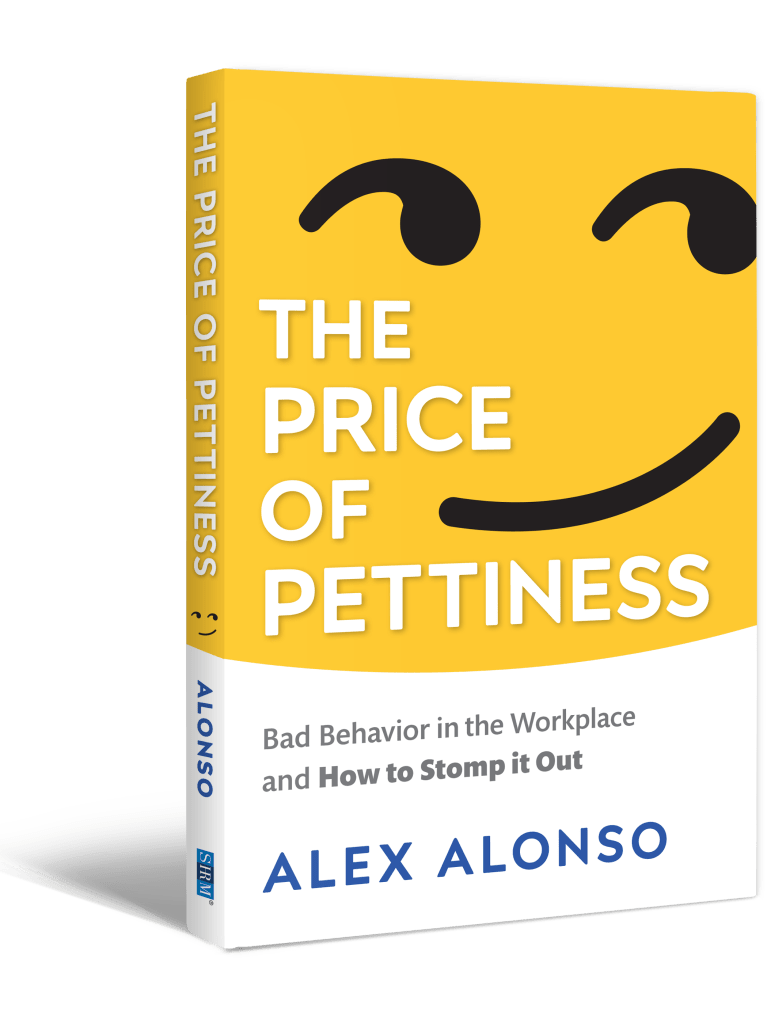This is the third of three excerpts adapted from The Price of Pettiness (SHRM, 2019), written by Alexander Alonso, Ph.D., SHRM-SCP.
The STOMP Checklist is more than a self-assessment. It can be easily applied to assess pettiness in others. I recommend its use in a variety of cases, including:
Mindfulness development. Using pettiness as a tool for understanding how to be mindful is arguably one of the more important applications of the STOMP Checklist. Mindfulness is invaluable when considering your own performance but is far more effective for helping others learn how to achieve a desired state of behavioral efficacy. Mindfulness flies in the face of behaviors that divide you from your present situation, and petty behaviors are among the most divisive.
Affect and job satisfaction. Affect is a term used in psychology to describe the experience of feelings or emotions—mood. Pettiness is correlated to affect, specifically, to negative affectivity, the experience of negative emotions such as anger, fear and contempt. By extension, negative affectivity is a correlate of job satisfaction. Low job satisfaction is often correlated to negative affect.
Think about it: being in a perpetually bad mood is often the outward manifestation of being unsatisfied with your job. These outward manifestations often transform into other behaviors, like complaining and lashing out at others. Hello, pettiness!
Teamwork and structure. Imagine knowing people's individual Pettiness Indices. Now imagine having a project that requires effective teamwork. With that data in hand, you can put together exactly the right team mixture you want, and you can structure leadership mechanisms to optimize the pettiness quotient needed for success. In other words, the STOMP Checklist represents a pettiness profile for your teams and an easy-to-use predictor of how the team's breakdowns will manifest. What leader wouldn't want this data?
The STOMP Checklist
| How often do you engage in the following behaviors? | WEIGHT | Never (-5) | Hardly (1) | Monthly (5) | Daily (10) |
| Act immaturely or childishly | 3 | | | | |
| Act unprofessionally | 2 | | | | |
| Complain about noise levels | 1 | | | | |
| Complain about odors from food or other sources | 2 | | | | |
| Criticize or ridicule someone for being intelligent | 4 | | | | |
| Devote obsessive attention to inconsequential matters | 3 | | | | |
| Do not stop infighting among team members/ within or between teams in other business units | 3 | | | | |
| Discount someone's contributions because of a personal bias or dislike | 3 | | | | |
| Exclude key stakeholders from meetings/ discussions/communications | 4 | | | | |
| Generally contribute to or do nothing to address an overall environment of pettiness | 3 | | | | |
| Instigate or encourage infighting among team members/within or between teams in other business units | 4 | | | | |
| Ostracize someone who has new ideas | 4 | | | | |
| Pick on someone who is unpopular | 4 | | | | |
| Play practical jokes | 3 | | | | |
| Push a personal agenda | 2 | | | | |
| Refuse to acknowledge someone's contributions | 4 | | | | |
| Refuse to work with someone | 3 | | | | |
| Suggest that someone lacks intelligence | 1 | | | | |
| Throw a tantrum | 4 | | | | |
| Take credit for someone's work or the work of a team | 4 | | | | |
| Torpedo, derail or cancel someone's project because of personal bias or dislike | 4 | | | | |
| Undermine a boss or co-worker to their peers | 3 | | | | |
| Undermine a boss or co-worker to their superiors | 3 | | | | |
| Withhold information from those who needed it to perform their work | 3 | | | | |
| TOTAL = ? = Pettiness Index | |
Alexander Alonso, Ph.D., SHRM-SCP, is SHRM's Chief Knowledge Officer.
Visit the SHRMStore to order a copy of The Price of Pettiness.
Was this resource helpful?



